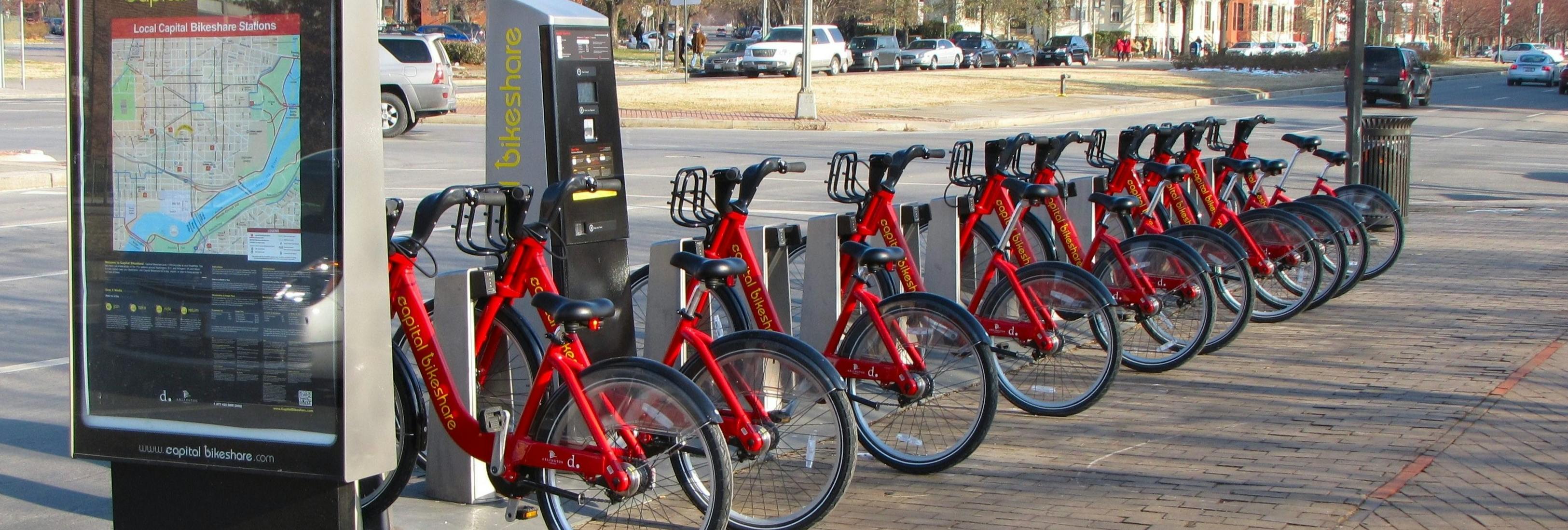FAQs
- Users can rent bikes for a single ride or purchase daily, monthly, or annual memberships. Bikes may be checked out using a smartphone app or at a solar-powered kiosk at each station.
- Users can choose traditional pedal bikes or an e-bike, which provides a battery-assist while pedaling.
- Pedal bikes must be checked out and returned to a station. E-bikes may be docked at fixed stations or parked anywhere within the defined service area; however, users incur an additional fee when an e-bike is not parked at a station.
- Capital Bikeshare staff rebalance bikes throughout the day, adding bikes to empty stations and removing bikes from full stations to ensure bikes and bike parking docks are available.
- Population and employment density (multifamily developments, employment centers, etc.)
- Destination density
- University or school
- High density of retail, parks, or other community destinations
- Transportation network connectivity
- Metrorail station (within 2 miles)
- Access to bicycle trails, bike lanes, neighborways, etc.
- Access to complementary facilities, such as bus stops and scooter corrals
- Proximity to other bikeshare stations (typically within ¼ to ½ mile)
- Visibility and accessibility
- Public input in the 2019 Bikeshare Feasibility Study
- Other local factors
- Commuter Choice funding was awarded to install stations near the Vienna Metrorail station to improve commuter access to transit in the I-66 corridor. (https://novatransit.org/programs/commuterchoice/)
- Transportation Alternatives funding was awarded to expand transportation options between Old Town Fairfax and George Mason University. (https://www.fhwa.dot.gov/fastact/factsheets/transportationalternativesfs.cfm)
- Bikeshare stations will be incorporated in the Old Lee Highway multimodal improvement project to create a continuous network of stations between Old Town and Fairfax Circle. (http://www.fairfaxva.gov/oldleehwy)
How does Capital Bikeshare work?
There are more than 500 Capital Bikeshare stations throughout the D.C. metro area, and the process to rent and return bikes is the same across jurisdictions.
For more information, visit https://capitalbikeshare.com/.
How were the proposed bikeshare stations selected?
Bikeshare station locations were selected based on several criteria:
From a technical perspective, bikeshare stations must be on hard, level, city-owned property or on an easement and receive enough sunshine to run solar-powered equipment. Stations must be clear of obstacles and conflicts, such as utilities, pedestrians, traffic, and fire access, and must have access for Capital Bikeshare vans to rebalance the bikes throughout the day.
The location must also have enough space to accommodate the station. The smallest typical station has 12 parking docks, and the total footprint for a typical station located on a sidewalk measures 35 feet long by 7 feet wide. A typical on-street station is 43 feet long by 7 feet wide (including additional buffer space from on-street parking).
Why are some stations proposed on the side of a street?
Bikeshare stations are frequently located on-street, typically in an on-street parking lane. These spaces typically meet the technical requirements for station installation without requiring additional infrastructure. It also provides easy access from the station to an adjacent bike lane or on-street bike route. While on-street stations may sometimes replace a curbside parking space for private vehicles, they may also help provide additional travel options and reduce demand for private vehicle parking at destinations that attract many types of trips.
It is important to consider safety when considering how to configure an on-street station. Typically, an on-street bikeshare stations are feasible on a low-volume street (less than 3,000 cars per day) and are complementary with streets that are designated bike routes. On busier streets, a larger buffer between the bikeshare station and the vehicular travel lane may be required. The station may be placed next to an on-street bike lane or in a wide shoulder.
Why aren’t there any stations proposed in other neighborhoods or Activity Centers?
The station locations proposed in this project were selected to create a continuous network of stations. Bikeshare systems work best when stations are closer together (typically 1/4-1/2 mile apart), making it easier for users to find a bike nearby and to make short trips between destinations. The city’s initial network of stations is designed to expand travel options and connectivity between George Mason University, Old Town Fairfax, Old Lee Highway, Fairfax Circle, and the Vienna Metrorail station.
Once the city’s network is established, if there is demand for additional stations at other locations, the network of stations may be proposed for expansion as a future project.
How are the city’s bikeshare stations funded?
There are three primary funding sources for the current project:



